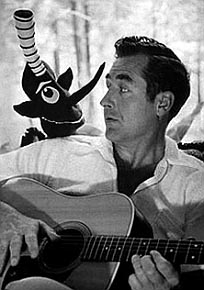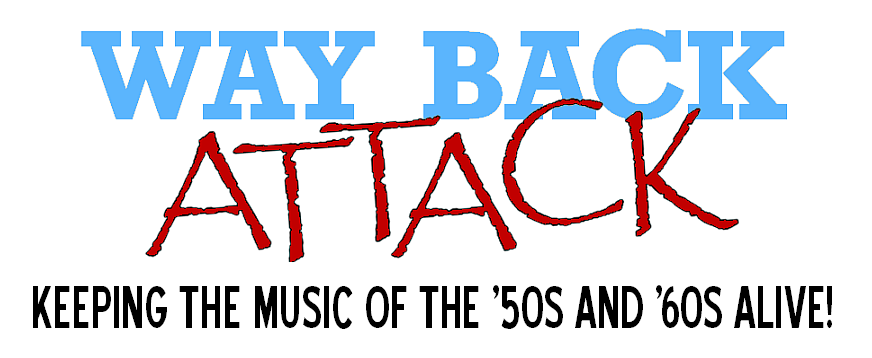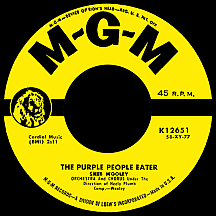SHEB WOOLEY
The Purple People Eater
When a guy like Sheb Wooley sets out to be a successful country singer, the end result isn't always as originally planned. Sheb was different from a lot of western-style musicians, always taking a lighthearted, often humorous approach to the music he made. Self-composed songs like "Mule Boogie" ('...how that mule could kick!'), "Down in the Toolies" and "You're the Cat's Meow" possessed a lightness of spirit that leaned in a more comical direction as time went by. His signature hit, one of the top-selling records of the 1950s, was way out in the stratosphere, a kid-appeal ditty based on the punch line of one of the hokiest of jokes: "What has one eye, one horn, flies and eats purple people?"
Growing up in Erick, a wide spot in the road on the western edge of Oklahoma, Shelby Wooley spent much of his teen years on horseback and put in some time riding in regional rodeos. Though he played guitar and led a country band during high school, it appeared working as a welder might be the best job he could ever hope to have. In 1940, when he was 19, he married Melba Miller (she and her brother, future country star Roger Miller, were raised in the same town) and moved to the Los Angeles area, but job opportunities for an "Okie from Erick" were scarce. Heading to Nashville at the end of World War II, he landed a job singing and playing guitar at WLAC, a 50,000-watt station with a signal that reached many midwestern and eastern states. A 1946 release on a recently-established local record label, Bullet, resulted; "Oklahoma Honky-Tonk Gal" ('...she's half Cherokee!') was typical of the time and gained little attention outside the immediate area. Soon afterwards he moved to Fort Worth, Texas, waxing three locally-popular hillbilly discs on the Blue Bonnet label in '47 and '48 featuring his Calumet Indians backing band.
A big break came when MGM Records picked him up near the end of 1948. Good thing the major label recognized his potential, as it was several years before his recordings generated any large-scale interest. In 1950 he returned to L.A. and began appearing in bit parts in Hollywood western films; his first, in Rocky Mountain starring Erroll Flynn, led to a role the following year in Little Big Horn, plus two episodes of NBC's Fireside Theatre and his big break, playing a bad guy in 1952's Oscar-winning High Noon starring Gary Cooper. Supporting roles in movies (Cattle Town, Texas Bad Man, The Boy From Oklahoma) and on TV (The Cisco Kid, The Adventures of Kit Carson) established him as a familiar face in the shoot-'em-up shows so dominant during the era.
Sheb's songwriting improved over that period, his wordplay becoming increasingly whimsical and descriptive with tunes like "A Cowboy Ought to Be Single," "Freight Train Cinders in My Eyes" and "Speak of the Devil." He came close to having a hit in late 1955 with the love-lost romantic song "Are You Satisfied?," cowritten with Homer Escamellia, his first record to appear on the national charts, though only briefly. Rusty Draper had a major hit with his cover version in early '56; Toni Arden and R&B singer Ann Cole also had success with their versions. Seven more Wooley singles were released through 1957 to no avail, some ("The Birth of Rock and Roll," "First Day of School") attempting to zero in on younger listeners. After hearing Betty Johnson's unusual space age novelty hit "The Little Blue Man" in early '58, he was inspired to write "The Purple People Eater," basing it on the silly joke that was actually much funnier when played out in song. The one-eyed monster's voice was achieved by speeding up the tape, a trick that had been done before; David Seville used the same device in creating "The Witch Doctor," beating Sheb to the punch when his pre-Chipmunks single hit number one in April.

Wooley's title character referenced rock and roll hits ('...a-bop-bop-a-loopa-lop-a-loom-bam-boom,' an obvious nod to Little Richard's "Tutti-Frutti," and 'I like short shorts,' straight out of the current Royal Teens hit); Sheb described an unlikely TV show scenario ('He was blowin' it out, a-really knockin' 'em dead...playin' rock and roll music through the horn in his head!') with a "big finish" from the invading scamp, aping The Champs' chart-topper "Tequila" (or as he says it, 'Ta-keee-la!'). Session saxophonist Plas Johnson, by the way, supplied the pitch-adjusted horn performance. "The Purple People Eater" debuted in the national top ten the first week in June. A week later, the single was number one and remained there until mid-July while "Witch Doctor" continued to hover in the top ten. These otherworldy creatures with high-pitched voices had taken over the airwaves!
Record companies rushed to cash in on the Purple Mania: The Big Bopper and Rick Johnson penned an ode to both novelty characters, "The Purple People Eater Meets the Witch Doctor," a minor hit that summer for Joe South. Clint Miller pointed out the usefulness of another creature, the "Polka Dotted Poliwampus" (who '...eats purple people eaters'). Meanwhile, Wooley used the speedy-voice trick to simian extreme on his follow-up, "Monkey Jive," then recounted his hungry lavender creature's wintertime antics with "Santa and the Purple People Eater." All the exposure may have helped his acting career, which reached its peak when he landed the role of scout Pete Nolan on Rawhide (the CBS-TV western series that established soon-to-be superstar Clint Eastwood), which premiered in January 1959 and lasted eight seasons. The following year he recorded a related album, Songs From the Days of Rawhide.
A "normal" record, "Sweet Chile," describing the charms of a bayou girl, hit the charts in the summer of 1959. He then took the vari-speed gimmick to its lowest level with "Pygmy Love," featuring a chorus of teeny-tiny voices. "Skin Tight, Pin Striped, Purple Pedal Pushers" made a fashion statement (consistent in color, at least) in 1961, but none of these farcical offerings connected. Returning to his C&W foundation, he scored a number one country hit in March 1962 with "That's My Pa," a yodelin', horse-laughin' backwoods delight (then he made an about-turn with "That's My Ma," a spoken word weeper). Later that year he adopted a pseudonym, Ben Colder (after considering several other names including "Klon Dyke"), with an intended one-shot, "Don't Go Near the Eskimos," a parody of Rex Allen's hit "Don't Go Near the Indians." The song was silly, but not particularly offensive, and was a fair-sized hit.
Here's where things got ugly. Sheb made a second Colder record, "Hello Wall No. 2," an unfunny, inebriated takeoff on Faron Young's "Hello Walls." Fans reacted positively, which opened the floodgates for a long series of raging-drunk remakes purportedly done for laughs. Often indecipherable, these intelligence-insulting satires of hit songs came at a steady clip; "Still No. 2," "Detroit City No. 2," "Almost Persuaded No. 2" and "Harper Valley P.T.A. (Later That Same Day)" were hits, reaching an audience that somehow enjoyed listening to mostly-spoken alcohol-fueled rants (Johnny Bond did a better job with the drunk routine...and he knew when to stop). Wooley made Ben Colder records for more than ten years and even appeared playing his intoxicated alter-ego on the TV series Hee Haw, and we're all worse off for it.
In between the Colder tirades, Sheb kept it real (it was an alternating Jekyll-Hyde kind of situation) with several country hits over the years ("Blue Guitar," "I'll Leave the Singin' to the Bluebirds"), occasionally having fun (like with the pseudo-autobiographical "Wild And Wooley, Big Unruly Me"), growing more sappily sentimental as the decade wore on ("Tonight's the Night My Angel's Halo Fell," "Tie a Tiger Down," "I Remember Loving You"). He remained with MGM through 1973 and made recordings for small labels for several years afterwards, also keeping his acting career going through 1990. In '88 he had a small role in the family film Purple People Eater starring Ned Beatty and Shelley Winters, loosely based on his 1958 hit. Overall, Sheb Wooley's career was quite unlike anyone else's, with an impressive list of colorful film and TV roles and some four decades' worth of musical output running the gamut from seriously down-home hillbilly tunes to absurdly unbalanced pop novelties - all of them overshadowed by a still-lurking space creature with an oversized eyeball, built-in head horn and a preference for the taste of purple-skinned earthlings.


